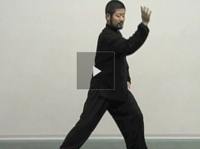Theory and practice of scissors power
Presenter: Chen Zhonghua Length: 14 min. In: English Year: 2015 Difficulty:2/5 At:Toronto
The important components: 1. Having 2 lines, 2. Having separation 3. Resolve through rotation (one line is the catch or lock and the rotation provides the other action for the other line). Click on the gif
I’ll show you the lines.
“If you only have one line, you’re going back and forth.” In this video Master Chen teaches how to create two separate lines to “cut” an opponent like a pair of scissors. Below Master Chen created 2 lines on Kelvin as indicated by the red arrows. These lines are independent from one another yet work together. Clearly upper body and lower body separation is a prerequisite for this to work. Please refer to the video to see what happens after these two lines “cut”. Notice the lower line is fixed (it’s a lock) and the upper line cuts by way of waist rotation.
Click on the GIF to see the “cut”. Do you see the 2 lines crossing?
The Second picture Master Chen establishes 2 separate lines on Hugo. The difference is the line on top is fixed and the line on the bottom does the “cutting”.
Below click on the gif to see cut. Can you see the lines cross? Since the top is locked and the bottom provides the action, Hugo’s lower body is cut out underneath him.
Can you find the lines?
With this student, Master Chen uses different angles. Where are the lines and where is the cut? Click on the gif to see or watch video.
When Master Chen does the move on Brennan, instead of lines, he does it with spirals…remember, a spiral is a stretch (line) with a rotation. Can you see the two spirals? Click on gif…this is more difficult to see!
This cut Master Chen does on Hugo is very small, subtle and precise…it is hard to see…can you see it? Click on the gif.










{ 3 comments… read them below or add one }
Hi, if i could ask, is it the point where the two lines meet that is projected? Thanks
I [think] the point where the two lines meet is where the opponent is “cut” [and squeezed/forced out]
‘ Scissor Power ‘
Fundamental Taiji theory states that One ( wuji ) becomes Two ( taiji ). A single thing becomes differentiated into two clearly defined and separate aspects.
Master Chen teaches us fundamentally that the ‘ single ‘ thing is us. We must develop the ability to become two, and functionally act like a pair of scissors. Scissors are essentially two separate knife blades, but when pinned together, by a hinge, they become a simple lever and also have the ability to work together, while remaining separate. This is the basis of what we try to do.
Because of the hidden nature of taiji application, many think that ‘ whole body power ‘ means using the body as one ( in an effort to generate more power or a special type of power ), but this actually goes against the nature of taiji, and the very definition of taiji itself. Although the two pieces must work together, first you must separate clearly into two.
In this video Chen Zhonghua, shows some powerful applications of the ‘ scissor power ‘, and helps students to work on fundamentals of separation.